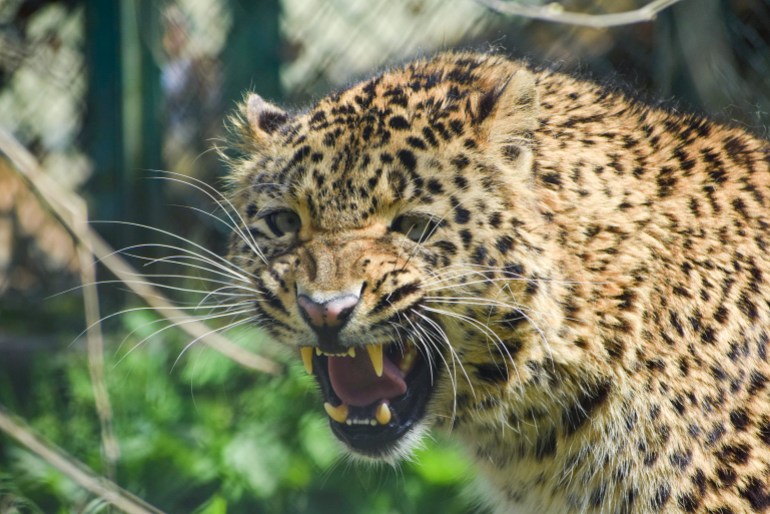‘Conflict within conflict’: Wild animal attacks rise in Kashmir
Nearly 200 people have been killed and more than 2,000 others wounded in man-animal conflict in the region since 2011.
![Leopard attacks have increased in Indian-administered Kashmir during the COVID-19 pandemic [Basit Zargar/Al Jazeera]](https://www.aljazeera.com/wp-content/uploads/2021/06/SAVE_20210619_150136.jpg?resize=770%2C513)
Srinagar, Indian-administered Kashmir – For more than two weeks, hunter Shabir Ahmad clutched his weapon – a bore gauge gun that can shoot up to 80 pellets at a time – close to his heaving chest and scanned the lush forests of Indian-administered Kashmir like a hawk.
The hunter was looking for a leopard that mauled a five-year-old girl earlier this month while she was playing on her lawn in the Himalayan region’s Budgam area.
The child’s family heard her scream and ran outside, only to find her doll and footwear lying in the mud.
Ahmad works for the local wildlife department, which set up a wild animal nursery in Budgam, from where the leopard prowled out on June 4 and killed the girl, whose mauled body was found at dawn the next day.

Ahmad, who said he has rescued nearly two dozen leopards from different localities across the Kashmir valley and relocated them to wildlife sanctuaries or protected reserves, was hired to capture the leopard.
“But the man-eater who later turned out to be a full-grown female had perhaps sensed a massive hunt,” he told Al Jazeera.
“She surfaced closer to human habitations before we finally laid a trap for her.”
It was not an isolated incident. There has been a rise in human encounters with wild animals in the territory, with many calling it a “conflict within conflict”.
Kashmir is claimed in its entirety by both India and Pakistan, who rule over parts of it.
An armed rebellion to demand independence from India or a merger with Muslim-majority Pakistan began in the early 1990s and has since claimed tens of thousands of lives, making Kashmir one of the bloodiest conflict zones in the world.
Now, the man-wild encounters are creating new anxieties in the restive region already grappling with the decades-old conflict.
Earlier this year, the region’s main city of Srinagar was rattled when an adult leopard sneaked into a housing colony. Black bears have also been seen roaming in the residential areas.
The surge in such encounters with wild animals spiked during the coronavirus lockdowns when people were confined indoors and the streets were empty. Those living in the vicinity of the green belts have been told by the authorities to be cautious.
According to official data, nearly 200 people have been killed and more than 2,000 others wounded in man-animal conflict in the region since 2011. Until June this year, at least 10 people have died and 141 injured in such conflicts.

Experts blame deforestation for the rising attacks.
“It is a man-made disaster,” Kashmiri environment activist Raja Muzaffar Bhat told Al Jazeera.
“There has been massive deforestation in the Pir Panjal forest division in the last few years,” he said, referring to three forest ranges that saw most of the attacks by wild animals.
The wildlife authorities say they are trying to implement safety measures, particularly in residential areas near forests.
“As soon as we get a call regarding the presence of a leopard somewhere, the first course of action is to send the team on ground with a response time of not more than 10-20 minutes,” senior wildlife warden Altaf Ahmed told Al Jazeera.
“After scanning the whole area, our team looks for evidences like pugmarks or faecal matter and further establishes the most normal routine tract followed by the animal. Once the team picks their spots, they install automatic trap cages.”
The cages would contain a bait – a dog or sheep – to entice the leopard. “And that is exactly how the Budgam man-eater was caught,” said the warden.
Environmental experts link the crisis with climate change in the region, calling it an inevitable cause for the decreasing habitat for animals.
“As the climate changes, the floral biodiversity gets disturbed, creating a scarcity of food in the forests which compels the wild animals to take to streets,” Nadeem Qadri, a noted environmental lawyer from Kashmir, told Al Jazeera.
“There is also a misnomer among people that only deforestation leads to the degradation of their habitat. Going for the extraction of a rare medicinal herb, on which some mammalian species are dependent for food, is equally a reason for the conflict.”

The region’s wildlife department is planning to plant 80 percent of fruit and fodder trees to help the herbivorous animals get their food within the jungles. This, they believe, will help the carnivores get their prey inside the jungle itself.
“There is no need to panic as humans and animals are supposed to coexist,” wildlife official Rashid Naqash told Al Jazeera.
“But while animals have been sharing space with the humankind since the early times, the present crisis has been triggered by a lot of small green vegetations that have come up very close to the human habitations, offering a conducive environment for the leopards. And that’s how they adapted to this lifestyle and started to throng the urban areas.”
Naqash said there has been a significant change in land use in the region in the last 30 years, with human settlements going deep inside the forests, and orchards and crop fields overtaking wild spaces. And that is how, he said, the habitat of animals was disturbed.
“Humans have encroached upon the corridors and buffer areas that used to be between the forest area and settlement zones,” the wildlife official said. “Since animal-human interface has gone high, so has the conflict.”
Wild animals are usually more aggressive during the morning and evening hours and can even resort to killing humans during those times. That explains why the Budgam girl was attacked in the evening.
“A leopard would usually attack a small child since it would get an impression that it matches the size of its prey [sheep and dog] and can drag it easily,” Naqash said.
Authorities have also set up 22 control rooms to attend to SOS calls and have launched awareness programmes for the residents.
“The wildlife department cannot stop these incidents but we are trying to minimise damages by using electronic and print media to make people aware of the possible threats,” Naqash said.
Meanwhile, given the anger and anguish over the killing of the Budgam girl, hunter Ahmad said he was expected to go only for the kill.
“But we need to understand that leopards are designated endangered animals and only 14,000 are estimated to be left in the whole of India,” he said.
“While proper action has to be taken to prevent leopards from coming towards human settlements, encroachment of jungles and deforestation should be stopped on a war-footing to prevent these wild attacks.”

No comments:
Post a Comment